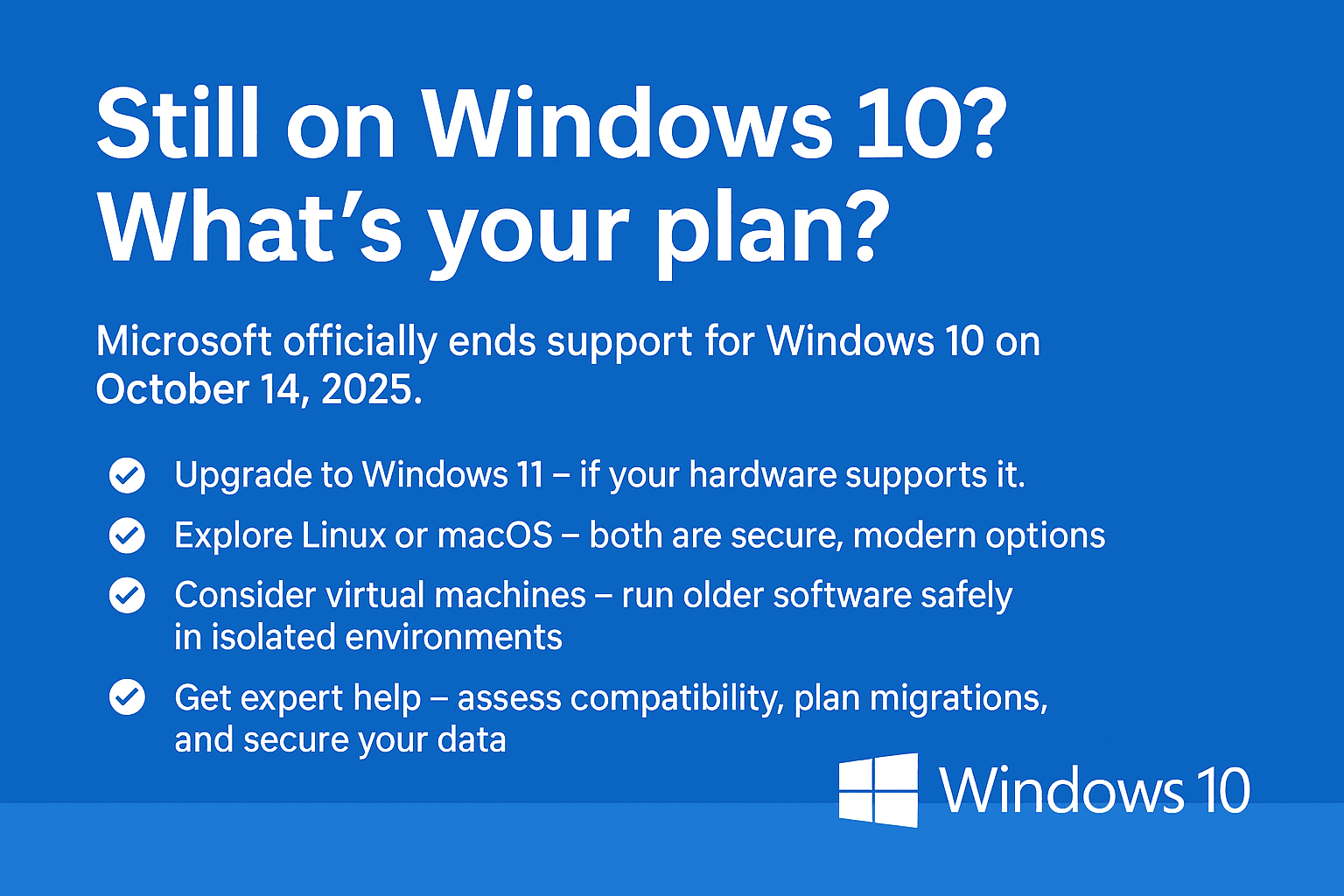
Windows 10 End of Life 2025: Upgrade, Replace, or Switch?
Windows 10 support ends October 14 2025. Protect your business before it’s too late.

Think your business runs smoothly with computers today? Imagine trying to manage your company with just paper, filing cabinets, and typewriters. That was reality for most businesses until the early 1980s. Then IBM changed everything with a simple but powerful idea that still affects how your business operates today.
Before 1981, computers cost as much as a house. Only big companies could afford room-sized machines that needed special air conditioning and full-time technicians. Small and medium businesses were locked out of the computer revolution.
Then IBM did something that shocked the tech world. Instead of building everything from scratch like other computer companies, they used parts anyone could buy. This decision didn’t just make computers cheaper—it created the foundation for every business computer you use today.
When IBM released the Personal Computer (PC) in 1981, they made three decisions that changed business forever:
Open Design: Unlike competitors who kept their technology secret, IBM published how their computer worked. This meant other companies could build compatible parts and software. More competition meant lower prices and better options for businesses.
Standard Parts: Instead of custom-built components, IBM used parts from different suppliers. This approach reduced costs and made repairs easier—principles that still guide smart IT purchasing today.
Business Focus: While other computers targeted hobbyists, IBM aimed straight at offices. They understood that businesses needed reliable, professional machines with good support.
In 1983, IBM introduced the XT (eXtended Technology). This wasn’t just an upgrade—it was the first computer truly designed for business use. Here’s what made it special:
Built-in Hard Drive: For the first time, businesses could store important files directly on the computer instead of using floppy disks. No more hunting through stacks of disks to find last month’s sales report.
More Memory: The XT could handle bigger spreadsheets and more complex documents. This meant businesses could finally replace those massive paper ledgers with digital files.
Better Reliability: Unlike earlier computers that crashed frequently, the XT was built to run all day in busy offices.
The IBM PC and XT didn’t just bring computers to small business—they brought powerful business tools:
Spreadsheets: Programs like VisiCalc and later Lotus 1-2-3 let business owners create budgets, track expenses, and run “what-if” scenarios instantly. No more spending hours with calculators and ledger books.
Word Processing: Documents could be edited, corrected, and reprinted without starting over. Proposals looked professional, and contracts could be updated quickly.
Database Management: Customer lists, inventory tracking, and employee records became searchable and organized. Finding information went from hours to seconds.
Financial Management: Small businesses could finally afford accounting software, making bookkeeping faster and more accurate.
Understanding this history isn’t just interesting—it’s essential for making smart IT decisions today. The principles IBM established in the 1980s still guide successful business technology:
Avoid Vendor Lock-in: Just like IBM chose open standards, your business should pick technology that doesn’t trap you with one supplier. This keeps costs down and options open.
Plan for Growth: The XT succeeded because it could be upgraded. Your technology should grow with your business, not hold it back.
Focus on Business Value: Don’t buy technology because it’s cool. Buy it because it solves real business problems and improves productivity.
Invest in Reliability: Cheap technology that breaks constantly costs more than quality equipment that works reliably. IBM understood this 40 years ago.
Whether you’re running a 20-person company or a 200-person organization, these lessons apply:
Choose Scalable Solutions: Your accounting software, customer management system, and communication tools should handle growth without requiring complete replacement.
Standardize When Possible: Having different systems that don’t work together creates the same problems businesses faced before the IBM PC. Standardization saves time and money.
Plan for the Future: Technology changes fast, but business needs are consistent. Focus on solutions that solve core business problems: communication, data management, customer service, and financial tracking.
Get Professional Guidance: Just as businesses needed IT support in the 1980s, you need expert advice today. The stakes are higher now—your entire business depends on technology working correctly.
The IBM PC proved that the right technology, implemented correctly, can transform how a business operates. Today’s cloud computing, mobile devices, and business software all trace back to IBM’s decision to make computers accessible to regular businesses.
Your company faces the same choice IBM offered in 1981: embrace technology that improves efficiency and competitiveness, or watch competitors gain the advantage.
The difference is that today, you don’t have to figure it out alone. Professional IT support can help you make the same smart decisions IBM made 40 years ago—choosing technology that serves your business goals, not the other way around.
To learn more about the history of the IBM PC and its impact, visit the IBM Personal Computer page: https://www.ibm.com/history/personal-computer
What was your first business computer? How did technology change the way you work? Share your experiences in the comments below—we’d love to hear your story!

Windows 10 support ends October 14 2025. Protect your business before it’s too late.

Cybercriminals are using fake CAPTCHA websites to hijack clipboards and install malware. Find out how this scam works and what steps you can take to stay safe online. 🚨 Read more here!